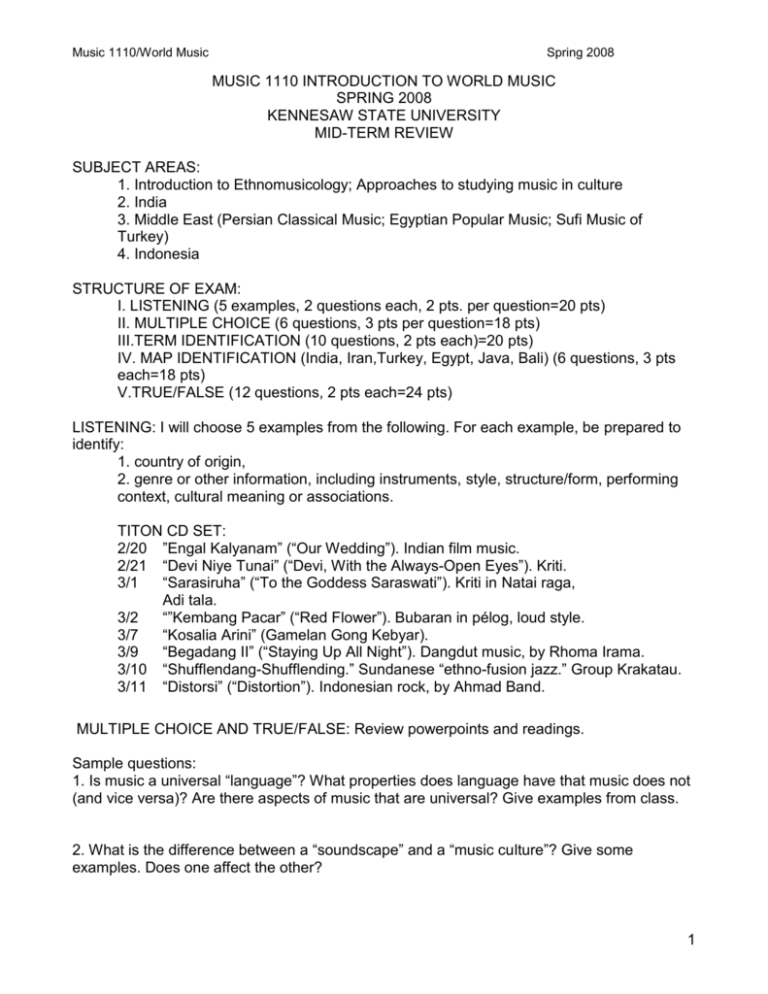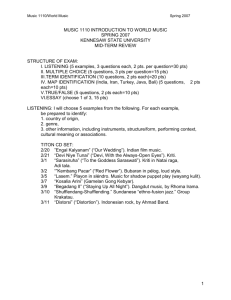music 1110 introduction to world music
advertisement

Music 1110/World Music Spring 2008 MUSIC 1110 INTRODUCTION TO WORLD MUSIC SPRING 2008 KENNESAW STATE UNIVERSITY MID-TERM REVIEW SUBJECT AREAS: 1. Introduction to Ethnomusicology; Approaches to studying music in culture 2. India 3. Middle East (Persian Classical Music; Egyptian Popular Music; Sufi Music of Turkey) 4. Indonesia STRUCTURE OF EXAM: I. LISTENING (5 examples, 2 questions each, 2 pts. per question=20 pts) II. MULTIPLE CHOICE (6 questions, 3 pts per question=18 pts) III.TERM IDENTIFICATION (10 questions, 2 pts each)=20 pts) IV. MAP IDENTIFICATION (India, Iran,Turkey, Egypt, Java, Bali) (6 questions, 3 pts each=18 pts) V.TRUE/FALSE (12 questions, 2 pts each=24 pts) LISTENING: I will choose 5 examples from the following. For each example, be prepared to identify: 1. country of origin, 2. genre or other information, including instruments, style, structure/form, performing context, cultural meaning or associations. TITON CD SET: 2/20 ”Engal Kalyanam” (“Our Wedding”). Indian film music. 2/21 “Devi Niye Tunai” (“Devi, With the Always-Open Eyes”). Kriti. 3/1 “Sarasiruha” (“To the Goddess Saraswati”). Kriti in Natai raga, Adi tala. 3/2 “”Kembang Pacar” (“Red Flower”). Bubaran in pélog, loud style. 3/7 “Kosalia Arini” (Gamelan Gong Kebyar). 3/9 “Begadang II” (“Staying Up All Night”). Dangdut music, by Rhoma Irama. 3/10 “Shufflendang-Shufflending.” Sundanese “ethno-fusion jazz.” Group Krakatau. 3/11 “Distorsi” (“Distortion”). Indonesian rock, by Ahmad Band. MULTIPLE CHOICE AND TRUE/FALSE: Review powerpoints and readings. Sample questions: 1. Is music a universal “language”? What properties does language have that music does not (and vice versa)? Are there aspects of music that are universal? Give examples from class. 2. What is the difference between a “soundscape” and a “music culture”? Give some examples. Does one affect the other? 1 Music 1110/World Music Spring 2008 3. Describe Alan Merriam’s three-part model of music cultures. Give three examples of each of the three parts. 4. What are the sections of the kriti? What function do they have? Describe the use and function of improvisation in the kriti. 5. Describe typical performing forces for Indian classical music. What musical role does each play? 6. Describe the four groups of instruments in a gamelan in terms of function. 7. Describe the khandan-musiqi continuum and give some defining characteristics of each end of the spectrum. 8. Which music traditions of all we have studied were associated with court or royal patronage? Which are associated with religious practices or beliefs? 9. Which Indian city is described in detail at the beginning of the India chapter in your textbook? Where is it located? Why does it have two names? 10. What are the two main culture groups/language groups of India? (p.247) 11. Is Indian classical music an oral or written tradition. Explain. 12. How is raga different from a Western scale or mode? 13. How does a tala cycle differ from Western time signatures? 14. What are the two court cities in Java? What music/dance tradition is associated with them? 15. Why were gamelan orchestras considered to be symbols of status? 16. According to your textbook, what does the cyclic (colotomic) structure of Javanese gendhing represent? 2 Music 1110/World Music Spring 2008 17. Compare and contrast Javanese gamelan music of the court with shadow puppet music. 18. Compare and contrast Javanese gamelan music of the court with Balinese gamelan gong kebyar music. 19. Describe colotomic structure. 20. Compare the use of improvisation in Indian classical music with Javanese gamelan music. 21. Describe the music and dance in a Sufi Sema Ritual. What is its significance? 22. What is the definition of music used in this class? Why is the definition not more specific? 23. What is the definition of culture used in this class? How does it relate to "music-cultures"? 24. What is the music-culture model described in your text? What are the four areas it encompasses? 25. Why is it often not possible to transcribe non-Western music into Western notation? 26. What is the primary religion of south India? What influence does it have on classical music and dance? 27. List two distinctive characteristics of Indian film music. How does it differ from Indian classical music. Give some reasons for its popularity in India. What is a "playback singer"? 28. Compare and contrast Indian classical music with Persian classical music. How are they similar? How are they different? 29. The Arabic popular music industry arose in which city? Why did it arise here? Which famous singer is associated with this city? 30. What is the symbolic significance of the ney flute in Sufi music? 3 Music 1110/World Music Spring 2008 31. Describe "wayang kulit" or Javanese shadow puppet shows. What ensemble accompanies it? What role does the puppeteer have in these performances? TERMS: I will choose 10 terms from the following list for you to identify. Include country/culture when applicable. Carnatic khandan kriti usul raga Sufism tala Sema ritual mridangam slendro sitar pelog dastgah colotomic structure radif wayang kulit avaz Umm Kulthum tar Rhoma Irama 4





